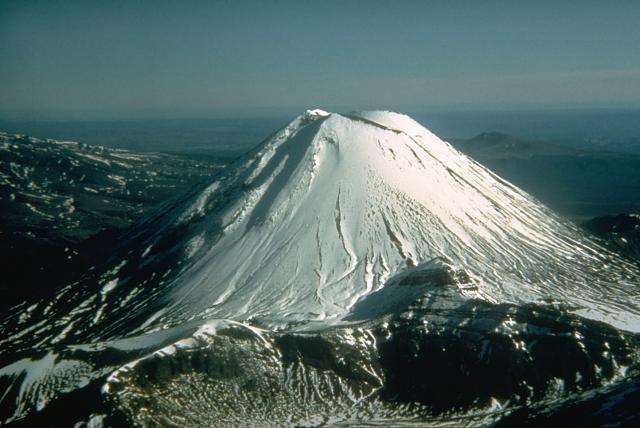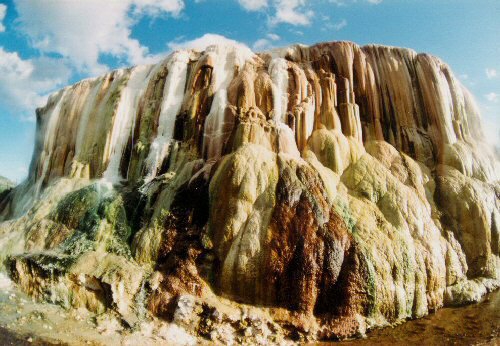|
Ngawha Geothermal Field
The Ngawha geothermal field is a geothermal area in the North Island of New Zealand. It is situated approximately 5 km east of Kaikohe and is centred on the village of Ngawha Springs. The field covers an area of around 25 km2, much smaller than the other major high-temperature geothermal field in New Zealand, the Taupō Volcanic Zone. The hot springs A hot spring, hydrothermal spring, or geothermal spring is a Spring (hydrology), spring produced by the emergence of Geothermal activity, geothermally heated groundwater onto the surface of the Earth. The groundwater is heated either by shallow ... arising in this area are slightly acidic and are rich in ammonia, bicarbonate, boron and mercury, which is not typical of springs in New Zealand. Top Energy owns and operates the Ngāwhā Geothermal Power Station, which opened in 1998 and has been expanded several times since. References Geothermal areas in New Zealand Kaikohe Far North District Landforms of the Nor ... [...More Info...] [...Related Items...] OR: [Wikipedia] [Google] [Baidu] |
Geothermal Activity
Geothermal activity is a group of natural heat transfer processes, occurring on Earth's surface, caused by the presence of excess heat in the subsurface of the affected area, usually caused by the presence of an igneous intrusion underground. Geothermal activity can manifest itself in a variety of different phenomena, including, among others, elevated surface temperatures, various forms of hydrothermal activity, and the presence of Fumarole, fumaroles that emit hot Volcanic gas, volcanic gases. Background physics Geothermal activity mostly appears in volcanic provinces, where it is fueled by the presence of a magma chamber. In some rare cases it can be caused by Coal-seam fire, underground fires or by large deposits of radioactive elements. Other sources of internal heating can be Planetary differentiation, gravitational differentiation of substances, tidal friction, metamorphism, or phase transitions. The release of heat to the surface occurs either in the form of a conductive h ... [...More Info...] [...Related Items...] OR: [Wikipedia] [Google] [Baidu] |
North Island
The North Island ( , 'the fish of Māui', historically New Ulster) is one of the two main islands of New Zealand, islands of New Zealand, separated from the larger but less populous South Island by Cook Strait. With an area of , it is the List of islands by area, world's 14th-largest island, constituting 43% of New Zealand's land area. It has a population of which is % of New Zealand's residents, making it the most populous island in Polynesia and the List of islands by population, 28th-most-populous island in the world. Twelve main urban areas (half of them officially cities) are in the North Island. From north to south, they are Whangārei, Auckland, Hamilton, New Zealand, Hamilton, Tauranga, Rotorua, Gisborne, New Zealand, Gisborne, New Plymouth, Napier, New Zealand, Napier, Hastings, New Zealand, Hastings, Whanganui, Palmerston North, and New Zealand's capital city Wellington, which is located at the south-west tip of the island. Naming and usage The island has been known ... [...More Info...] [...Related Items...] OR: [Wikipedia] [Google] [Baidu] |
New Zealand
New Zealand () is an island country in the southwestern Pacific Ocean. It consists of two main landmasses—the North Island () and the South Island ()—and List of islands of New Zealand, over 600 smaller islands. It is the List of island countries, sixth-largest island country by area and lies east of Australia across the Tasman Sea and south of the islands of New Caledonia, Fiji, and Tonga. The Geography of New Zealand, country's varied topography and sharp mountain peaks, including the Southern Alps (), owe much to tectonic uplift and volcanic eruptions. Capital of New Zealand, New Zealand's capital city is Wellington, and its most populous city is Auckland. The islands of New Zealand were the last large habitable land to be settled by humans. Between about 1280 and 1350, Polynesians began to settle in the islands and subsequently developed a distinctive Māori culture. In 1642, the Dutch explorer Abel Tasman became the first European to sight and record New Zealand. ... [...More Info...] [...Related Items...] OR: [Wikipedia] [Google] [Baidu] |
Kaikohe
Kaikohe is the seat of the Far North District of New Zealand, situated on State Highway 12 about from Auckland, and about from Whangārei. It is the largest inland town and highest community above sea level in the Northland Region. With a population of over 4000 people, Kaikohe is a shopping and service centre for an extensive farming district and is sometimes referred to as "the hub of the north". Geography The town is situated on a relatively level site surrounded mainly by undulating plains and is nearby many former pā sites including Nga Huha, Pouerua, Te Rua-hoanga, Ngaungau, Kaiaia, Te Tou o Roro, Taka-poruruku, Tapa-huarau, Nga Puke-pango, Maunga-turoto, and Maunga-kawakawa. On the western edge of town, Kaikohe Hill rises 300 m above sea level, allowing views of the imposing sand dunes on the Hokianga Harbour to the west, farmlands to the east and south toward Mount Hikurangi (625 m). To the north of the Putahi volcanic ridge is Lake Ōmāpere, five km in length, ... [...More Info...] [...Related Items...] OR: [Wikipedia] [Google] [Baidu] |
Ngawha Springs
Ngawha Springs () is a small settlement and hot water springs approximately five kilometres east of the town of Kaikohe in Northland, New Zealand. ''Ngāwhā'' means "boiling spring". The springs reputedly have therapeutic, balneological properties for those who bathe in their waters, and is the source of the steam used at the Ngawha geothermal field's power station. The nearby Northland Region Corrections Facility is the only prison in Northland. Ngāwhā Marae and its meeting house, E Koro Kia Tutuki, are a traditional meeting place for the local Ngāpuhi hapū of Ngāti Kiriahi, Ngāti Mau, Ngāti Rangi, Te Uri Hoatau and Te Uri Taniwha. Hot springs The main Ngāwhā Springs pool complex has 16 public pools and 8 private pools. The pools vary in temperature from the rather cool 32 °C / 89 °F to the extremely hot "Favourite" and "Doctor". The complex was refurbished in 2020–21, including a new building with changing rooms, a cafe, ticket office, shop an ... [...More Info...] [...Related Items...] OR: [Wikipedia] [Google] [Baidu] |
Taupō Volcanic Zone
The Taupō Volcanic Zone (TVZ) is a volcano, volcanic area in the North Island of New Zealand. It has been active for at least the past two million years and is still highly active. Mount Ruapehu marks its south-western end and the zone runs north-eastward through the Taupō and Rotorua areas and offshore into the Bay of Plenty. It is part of a larger Central Volcanic Region that extends to the Coromandel Peninsula and has been active for four million years. The zone is contained within the Tectonics, tectonic intra-arc continental Taupō Rift and this rift volcanic zone is widening unevenly east–west, with the greatest rate of widening at the Bay of Plenty coast, the least at Mount Ruapehu and a rate of about per year at Taupō. The zone is named after Lake Taupō, the flooded caldera of the largest volcano in the zone, the Taupō Volcano and contains a large central North Island Volcanic Plateau, volcanic plateau as well as other landforms. Activity There are numerous vol ... [...More Info...] [...Related Items...] OR: [Wikipedia] [Google] [Baidu] |
Hot Springs
A hot spring, hydrothermal spring, or geothermal spring is a Spring (hydrology), spring produced by the emergence of Geothermal activity, geothermally heated groundwater onto the surface of the Earth. The groundwater is heated either by shallow bodies of magma (molten rock) or by circulation through fault (geology), faults to hot rock deep in the Earth's crust. Hot spring water often contains large amounts of dissolved minerals. The chemistry of hot springs ranges from acid sulfate springs with a pH as low as 0.8, to alkaline chloride springs saturated with silica, to bicarbonate springs saturated with carbon dioxide and carbonate minerals. Some springs also contain abundant dissolved iron. The minerals brought to the surface in hot springs often feed communities of extremophiles, microorganisms adapted to extreme conditions, and it is possible that life on Earth had its origin in hot springs. Humans have made use of hot springs for bathing, relaxation, or medical therapy for th ... [...More Info...] [...Related Items...] OR: [Wikipedia] [Google] [Baidu] |
Top Energy
Top Energy Limited is an electricity distribution and generation company based in Kerikeri, New Zealand. It owns and manages the electricity lines network in the Far North District of New Zealand, including Kaitaia, Kerikeri and Kaikohe. The service area covers 6,822 km2 and serves over 32,000 customers. It also owns and operates the Ngāwhā Geothermal Power Station. Ownership Far North power consumers connected to Top Energy’s line network own the company, with the shares being held on their behalf by the Top Energy Consumer Trust. Distribution network The Top Energy distribution network is connected to the national grid at Kaikohe substation. The annual performance can be found in Top Energy's Group Annual Report on their website Ngāwhā Geothermal Power Stations Top Energy owns and operates the Ngāwhā Geothermal Power Stations on the Ngawha geothermal field. They utilise binary cycle technology manufactured by Ormat Industries and produce a total of 56MW. Ng ... [...More Info...] [...Related Items...] OR: [Wikipedia] [Google] [Baidu] |
Geothermal Areas In New Zealand
Located in a geologically active region, New Zealand has numerous Geothermal activity, geothermal features, including volcanoes of New Zealand, volcanoes, hot springs in New Zealand, hot springs, geysers in New Zealand, geysers and volcanic lakes. Many of these features cluster together geographically, notably throughout the central North Island's Taupō Volcanic Zone. These areas attract scientific interest and tourism; Geothermal power in New Zealand , power generators, Industry in New Zealand , industry and civil engineering also utilise them. Tourist areas *Whakarewarewa, Rotorua *Tikitere, Tikitere (Hell's Gate), north of Rotorua *Waimangu Volcanic Rift Valley, Waimangu, south of Rotorua *Waiotapu, south of Rotorua *Craters of the Moon (geothermal site), Craters of the Moon, Wairakei, north of Taupō *Orakei Korako, north of Taupō See also *Geothermal power in New Zealand *Hot springs in New Zealand References Geothermal areas in New Zealand, Geology of N ... [...More Info...] [...Related Items...] OR: [Wikipedia] [Google] [Baidu] |
Far North District
The Far North District is the northernmost Territorial authorities of New Zealand, territorial authority district of New Zealand, consisting of the northern part of the Northland Peninsula in the North Island. It stretches from North Cape (New Zealand), North Cape / Otou and Cape Reinga / Te Rerenga Wairua in the north, down to the Bay of Islands, the Hokianga and the town of Kaikohe. The Far North District Council is based in Kaikohe, and has ten ward councillors representing four wards: Te Hiku (in the north), Kaikohe-Hokianga (in the west), Bay of Islands-Whangaroa (in the east) and the district-wide Ngā Tai o Tokerau Māori ward. The council is led by the current mayor of Far North, Moko Tepania, who entered the role in 2022. Geography The Far North District is the largest of three Territorial Authorities of New Zealand, territorial authorities making up the Northland Region. The district stretches from the capes and bays at the northern tip of the Aupōuri Peninsula p ... [...More Info...] [...Related Items...] OR: [Wikipedia] [Google] [Baidu] |





